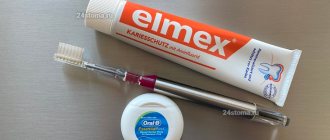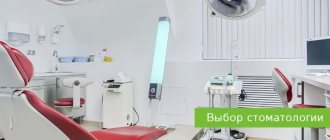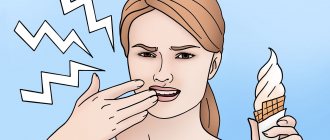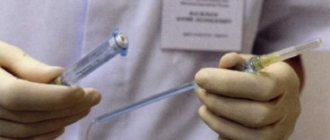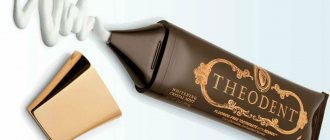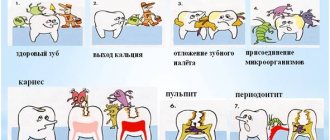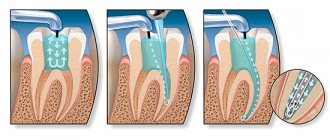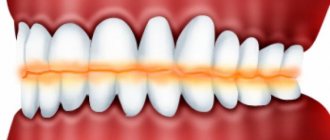Why are teeth drilled?
In dentists' language, drilling teeth means preparing. The doctor removes tooth tissue damaged by caries before placing a filling. However, teeth are drilled not only for treatment.
The tooth may be prepared to be covered with a crown. Prosthetics are needed if the doctor sees that restoring a tooth with a filling is unreliable. For example, when it is a front tooth and there is a risk of chipping due to increased load. Another reason is the small volume of healthy tissue. If the patient has deep caries, and even more so pulpitis, tooth restoration with a crown is indicated. In this case, the dentist drills the tooth in several stages. The doctor dissects it to remove caries-affected tissue to open the pulp chamber, gain access to the canals and widen them. At the last stage, after removing the nerve and treatment, the dentist drills the tooth, grinding it down for a crown.
The doctor is sometimes forced to dissect even healthy (without caries) and living (with nerve) teeth. This happens when veneers are placed. They are ceramic overlays for teeth. It happens that the front teeth are too small or there are large distances between them. It happens that a spot appears on a tooth due to fluorosis, enamel hypoplasia, or trauma. Sometimes a small part of the front tooth breaks off or the cutting edge wears off. There are simply very demanding patients when it comes to aesthetics. They want their front teeth to be the same shape, size and perfect appearance. In all these cases, installation of veneers is possible. Their advantage is that the tooth remains alive. It is not depulped and a small layer of enamel is removed (ground down).
Ozone treatment
The technology is based on non-contact exposure to ozone on the carious surface. This gas is formed when UV rays and electrical discharges combine. The resulting substance has sterilizing properties due to the instability of the OZ molecule.
Damaged tissue is removed contactlessly. When exposed to triatomic oxygen, the carious lesion is disinfected. The technique was first used by doctors from Germany. They used a machine that converted oxygen into ozone.
The process of treating a tooth with ozone
The stages of impact on the carious plane are as follows:
- A cap is placed on the tooth and connected to the HealOzone ozone therapy device.
- An environment close to a vacuum is formed inside the closed zone.
- After turning on the device, ozone is formed inside the cap, which begins to actively influence the microflora within 35-40 seconds. All microorganisms existing on the tooth die during this time.
- After disinfecting the carious area, the surface is covered with a special composition.
Indications for use in caries ozonation are as follows:
- Inflammatory processes in the gums.
- Diseases of the oral mucosa.
- Carious inflammation of root canals.
- Initial stages of caries.
- Fungal infections of the enamel.
- Difficulty in teething.
Ozone therapy drug HealOzone
The ozone therapy device is effective at the beginning of the destruction of enamel by carious bacteria. Ozone affects viruses and bacteria. Healthy cells are not destroyed during this time. The technique allows you to stop inflammation, activate the patient’s immunity and trigger regeneration processes.
The technique is considered the best option for treating childhood caries. Ozonation does not cause pain in the child, since the manipulations are absolutely painless. This method helps protect all of the child’s primary incisors from further destruction.
Ozone is hypoallergenic, so no negative reactions occur on the part of the patient’s body during or after the procedure. The procedure is painless and safe. Done in a short time.
- How to clean teeth from caries
The price for ozone treatment is from 1000 to 3000 rubles per tooth. Patients respond positively to the use of the technique in the initial stages of enamel destruction.
Before and after ozone therapy
Reference! With deep tissue damage, it is sometimes necessary to re-treat with drilling.
Drill teeth without pain
Some, especially the older generation, tell how they were treated without anesthesia not only for caries, but also for pulpitis. The doctor, by the way the patient twitched sharply, determined that the instrument had reached the nerve. Now everything is completely different. Anesthesia has become the standard in dentistry, with pain relief for both teeth drilling and extraction.
This is necessary, first of all, so that the patient in the dentist’s chair does not experience stress. Anesthesia also makes the doctor’s work more convenient. When the dentist just begins to dissect, it does not hurt the patient because there are no nerve endings in the enamel. But when the doctor approaches the enamel-dentin border, the person can jerk sharply in pain, and the dentist can damage the mucous membrane with the instrument.
Don't be afraid that the injection won't work. All modern anesthetics relieve pain equally well, and it does not matter how old a person is, what ailments he has or what medications he takes. A medicine can only “fail” if the doctor injects it in the wrong place. This happens either because the dentist is inexperienced, or because the nerve bundle runs slightly in a different place than usual. In such cases, they simply do it again in the right place.
Drilling teeth with an injection does not hurt. However, the patient feels the way the teeth are drilled, i.e., the vibration of the rotating instrument. The anesthetic blocks the type of nerve fibers that are responsible for pain. Completely different (proprioceptive) receptors are responsible for the sense of pressure and vibration. Fortunately, these sensations do not cause discomfort.
Laser
A person consists of 60-70% water. There is water in the teeth too. Laser tooth preparation is based on the fact that the laser beam causes water to boil in the tooth tissue. A series of micro-explosions occur in the enamel and dentin, and they begin to flake off.
Various types of lasers in dentistry are used to perform operations, treat caries and its complications, and clean and whiten teeth.
How effective? Honestly, I don’t know, I haven’t seen laser work. And I won’t say more about this, lest it turn out like the joke:
– And what did everyone find in these “Beatles”? I heard them. They burr, they fake it, their English is so-so. -Where did you hear them? - Yes, my neighbor sang to me!
No, I’ll still say a few words: there are contraindications, consultation with a specialist is necessary.
Anesthesia
Let's look at what else people are afraid of when they hear about pain relief.
- Pain from the injection. There are patients, especially children, who are frightened by the very injection of an anesthetic with a syringe. Doctors know about this, so they pre-lubricate the injection site with anesthetic gel. It reduces discomfort to a minimum. But it must be said that a good doctor makes the injection almost unnoticed.
- Allergy to anesthetic. The likelihood of its occurrence is negligible, much lower than the likelihood of food poisoning.
- Short duration of action of the anesthetic. Some are afraid that the “freezing” will disappear before the dentist finishes the work and pain will appear. Indeed, the duration of action of an anesthetic injection may vary slightly from person to person. The anesthetic will “work” faster in those who have better blood circulation in the area of pain relief. These same patients are more likely to “come away” from the injection. A doctor cannot predict this, but a good specialist is always interested in the patient’s feelings. If the analgesic effect decreases, the dentist transfers the next stages of work to another appointment.
- Side effects of anesthesia. Sometimes patients complain that immediately after the injection their arms and legs begin to tremble, their heart rate increases, etc. This reaction is caused by adrenaline in some anesthetics. In this case, the doctor selects another drug, without adrenaline or with a reduced content of it. There are plenty of such options, they are also used for children. Occasionally it happens that due to “freezing” a person’s eye cannot close. Don't be alarmed: this will go away as soon as the anesthetic wears off. It's all about the proximity of the anesthetized nerve to the optic nerve.
How long does it take to drill teeth?
It must be said that dental treatment is not always possible in one visit. And the reason for this is not the slowness of the dentist, but the careless attitude or fear of the patient, because of which he postpones the visit to the doctor.
Caries, when there is no need to depulpate the tooth (remove the nerve), is treated in one visit. Pulpitis is treated in two visits. After removing the nerve and cleaning the canals, the dentist places a temporary filling, and a medical pad under it. The patient is released for about a week. The next time the doctor asks if the tooth hurt. If not, then the channels are cleaned well. They can be filled and the tooth can be restored with a permanent filling.
It happens that the patient has brought the tooth to periodontitis, that is, when the inflammation has already spread to the tissues around it. Then the dentist injects medicine into the canals. After a few days, repeat the procedure, and so on several times, until the inflammation disappears. Further treatment is the same as the treatment of pulpitis.
Restoring a tooth with a filling, even without pulp removal, can be lengthy. How long it takes to drill a tooth depends on the size of the carious cavity. It often happens that a tooth is affected from several sides, for example, on the chewing surface and in the interdental space. In this case, the dentist creates several cavities for fillings. A lot of time is spent making the tooth indistinguishable from natural, healthy teeth. This is why doctors prefer to call the treatment aesthetic restoration. Of course, you can drill out a tooth and close it with a filling in 5 minutes, but high-quality work, when attention to detail is paid, takes 30 or 60 minutes.
Infiltration method
The procedure is carried out using Icon technology (infiltration concept). The authors of the method are the German company DMG. Icon is a minimally invasive treatment method that involves filling the affected area with a polymer mixture.
This technique is based on the use of a special chemical substance, which is used to influence the area of enamel affected by caries. The carious lesion on the molar is covered with gel, the damaged enamel is split from it. Upon completion of the splitting process, the gel is washed off with alcohol. The area cleared of damaged enamel is dried. A special resin with a polymer composition is applied to it. It fills the micropores of the tooth enamel and becomes one with it. At the end of the procedure, the infiltrate is dried using a polymerization lamp.
Dental treatment using Icon technology
The procedure allows you to preserve the integrity of the enamel for a long time. The material that fills the damaged area is much stronger than natural enamel, so microcracks do not form on the tooth for a long time, leading to the development of new foci of caries. Polymerization allows you to choose a color that completely matches the natural enamel of the tooth.
The duration of the treatment procedure is about 20-25 minutes. Without pain, discomfort, or overheating of the tooth, the carious plane is completely removed. One visit to the doctor makes it possible to remove caries lesions on all teeth at once.
Indications for use of the technique:
- Laser treatment of dental caries - how effective, safe and painless is the procedure?
- Removing chalk stains on enamel after removing braces. While wearing orthodontic structures in the area where they adhere to the tooth, the enamel is destroyed. Filling the damaged areas with a polymerizing composition stops further destruction of the enamel in these areas.
- Caries at the beginning of the development of the disease, if the destruction of the enamel is in the staining stage, infiltration allows you to preserve the enamel without destroying the tooth tissue.
- Location of caries in hard-to-reach places. When stains appear in the interdental spaces, it does not allow you to act on them with a drill without destroying the enamel on two adjacent teeth at once. The gel easily penetrates the interdental space and removes stains.
- Treatment of children. This method allows you to eliminate the fear of visiting a doctor.
Removing caries using Icon technology
Contraindications to the use of infiltration:
- age up to 3 years;
- caries in later stages.
This technology has earned a lot of positive feedback from patients and dentists. Some negative patient reviews are associated with violation of the procedure technology by an unqualified specialist. The cost of treatment for one tooth starts from 4,000 rubles.
Important! Correctly performed treatment in extremely rare cases leads to the continuation of the process of tooth destruction, which is associated with the individual characteristics of the enamel structure.
Before and after infiltration
Tools
What does a dental therapist use to drill teeth? The working tool is a turbine tip. Thanks to the motor, it rotates at a speed of 200-500 thousand revolutions per minute. More powerful tips have a larger head. A bur (diamond, steel or alloy) is installed in it. Burs come in different abrasiveness, shape, and size. This is determined by purpose. The turbine tip has a cooling system, and modern samples have a backlight.
How is a tooth treated?
Let's consider the stages of caries treatment, i.e. the situation when the tooth remains alive (with a nerve) and the canals are not filled.
When the anesthetic has taken effect, a rubber dam is placed on the tooth. This is a thin elastic film that protects the tooth from saliva or gum fluid.
The dentist drills out all tissues damaged by caries and creates a cavity for the filling. He then applies the etchant to the tooth for 10 to 40 seconds. This is a substance (acid) that removes sawdust after drilling and makes the tooth surface rough for better adhesion.
After washing off the etching, the doctor applies fluoride varnish, which strengthens the dentin and reduces tooth sensitivity. The next step is to apply bonding. This is a substance for the ligament of the tooth with the filling, which penetrates the dentinal tubules. To make the bonding harden, it is illuminated with a helium lamp. Its rays are harmless, it is just a blue LED lamp.
To place a filling, the dentist needs several types of filling material because different parts of the tooth have different colors and translucencies. The doctor applies an opaque dentin-colored material and illuminates it. A transparent layer (enamel) is applied to the incisal edge and exposed. Next, the doctor, to make the tooth look natural, forms the longitudinal ribbing of the tooth (mamelons). If the tooth is chewing, it creates grooves (fissures) between the cusps. Lights it up, removes the rubber dam and polishes it. Grinding is necessary not only for the beauty and shine of the tooth, but also so that plaque sticks to it less.
Next, the dentist checks the height of the filling. He places special paper, similar to copy paper, on the tooth. The patient makes several chewing movements, and imprints remain on the teeth at the points of contact. Using them, the doctor determines whether the filling is too high or too low. Makes changes if necessary. If this is not done, the filling will interfere with chewing and the bite will be disrupted.
Treatment of caries: photo
Treatment of dental caries using a specific example.
All main stages of caries treatment are shown in Fig. 15-23. Explanations for each photo appear when you click on it. Dental filling: photo
In this article, we tried to answer questions from people interested in caries treatment, such as: how to treat caries, how to remove caries, how to cure caries. We hope that you found this article at least somewhat useful. Read about the average cost of treatment for different types of caries in the article: “Cost of treatment.”
Sources:
1. Higher prof. the author’s education in therapeutic dentistry, 2. Based on personal experience as a dentist, 3. National Library of Medicine (USA), 4. “Therapeutic dentistry: Textbook” (Borovsky E.), 5. “Practical therapeutic dentistry” (Nikolaev A.).
Features of children's treatment
If the parent himself is afraid of the dentist and scares the child with him, then visiting the doctor will be problematic. Show that you treat visiting the doctor as something routine. Tell them that all your relatives and friends go to the dentist. If possible, take your child with you to your appointment. Play treatment at home, don’t tell them how teeth are drilled, but count them, look at them in the mirror.
On the day of your visit to the doctor, do not be too affectionate and do not shower him with gifts. This will alert the child. Don't threaten punishment. Don't come too early, don't sit in the hallway, because the baby may get upset because of the crying children.
A good pediatric dentist will never drill a child’s tooth out of the blue. He will talk to the baby using the definitions available to him. For example, do not drill, but buzz, do not give an injection, but smear with cold ice cream, do not treat, but take out the worm from a tooth, do not put a filling, but cover it with chewing gum. Expensive private clinics even offer an adaptation service, where the doctor plays with the child, teaches how to brush teeth, etc.
Local anesthesia is required; the baby should not feel pain. But please note that the clinic must have a license for children's treatment. Different dentists approach general anesthesia differently. It can be avoided in 99% of cases. Sedation is justified if a child with a strong gag reflex is undergoing treatment of lateral teeth, if the child is uncontrollable, if the previous treatment caused him severe psychological trauma.
Is it harmful to drill your teeth often?
Drilling teeth damaged by caries is not harmful, but necessary. Even a person who is careful about their oral hygiene may need treatment, and here's why. In the cervical areas, in the fissures of the lateral teeth, plaque accumulates faster due to limited access. In addition, the layer of enamel in these areas is thinner than, for example, on the masticatory hillocks. The emerging caries may not be noticeable to the patient, but it develops quite quickly.
It happens that a person sees a tiny dark spot on a tooth, and the doctor has to drill out a huge cavity and cover it with a large filling. How does this happen? The fact is that enamel is the hardest tissue in the body. Caries affects it more slowly than the dentin located along it. A small entrance hole in the enamel leads into a large cavity in the dentin.
If a person goes to the dentist because a tooth begins to hurt, it means that inflammation has begun, i.e. pulpitis. In this case, you will need to drill more. We can conclude that teeth are drilled more often in those who do not see a doctor on time or ignore preventive examinations.
How is dental treatment performed without a drill?
Patients in modern dental offices are increasingly less likely to hear the sound of a working drill. Dentists were able to stop drilling teeth thanks to the introduction of the latest techniques for treating carious surfaces.
The benefits of not having your teeth drilled are obvious. A comparison of traditional and new methods shows the clear superiority of treatment without a drill:
| Traditional methods | Techniques without drilling teeth |
| Touching the healthy part of the tooth when drilling, causing microcracks in the enamel | Removal of damaged areas without affecting the enamel on undamaged parts of the tooth |
| Painful process. The need for anesthesia | Painless procedures. Carrying out manipulations without anesthesia |
| Duration of the procedure. Creating discomfort with the sound of a drill | Fast completion of the procedure. The patient stays in a comfortable psychological environment |
| Risk of overheating of the pulp due to increased temperature in the area of operation of the bur | No risk of pulp overheating due to the non-contact procedure |
Important! Treatment without drilling teeth is an opportunity to maintain oral health without experiencing pain and fear.
Video - Treatment of caries without a drill
Expert advice
Before starting treatment, a good doctor always explains what he will do and why. Don't hesitate to ask your dentist anything you don't understand. A professional doctor is interested in caring patients. In addition, you must clearly articulate what results you expect from the treatment.
Describe your fears to the dentist. People are often afraid of the unknown, so the doctor should dispel doubts with his explanations, and also do everything to make you feel comfortable. If you trusted a specialist and agreed to treatment, then follow the doctor’s requests during the process.
Sometimes after filling there is a reaction to hot and cold. This is due to the fact that the filling material has a higher thermal conductivity than the tooth. In this case, the doctor uses a sealant. Another option is to wait; the sensitivity will decrease on its own over time. In six months everything will be as before. If after filling the tooth begins to react to acid, go to the dentist. This reaction indicates a leak in the filling.
Prevention of caries
A child who is teething needs to be seen by a pediatric dentist once. The doctor will check that everything is going as it should. Until the age of three, it is enough to come for an examination once a year. After three years, a child, like an adult, should visit the dentist twice a year.
Brush your teeth twice a day with a soft or ultra-soft toothbrush and low-abrasive toothpaste. Thanks to such a brush, you will never have a wedge-shaped defect, when the enamel in the cervical part of the tooth is erased due to excessive pressure. Brushes with bells and whistles don't make sense. The most important thing is the size of the head. The smaller the number, the more convenient and better the cleaning. For patient perfectionists, there are mono-tuft brushes. They clean best, but take a long time.
Children's teeth should be brushed from the moment they appear. When the child is too small, an adult does this with a fingertip. Children 3-4 years old can be taught high-quality cleaning using plaque detection indicators. These are chewable tablets or lozenges that color the plaque blue or red.
Thin dental floss will help remove plaque between the teeth and under the gums. Some complain that it injures the interdental papillae. In this case, you can use interdental brushes. The irrigator allows you to brush your teeth even better. It is especially needed for people with braces. All this, coupled with regular (twice a year) professional cleaning at the dentist, gives excellent results.
Don’t think that drilling a tooth is painful, because it is done under local anesthesia. If the doctor refuses to give an anesthetic injection, do not agree and go to another specialist. A good doctor will never put a patient under stress.
